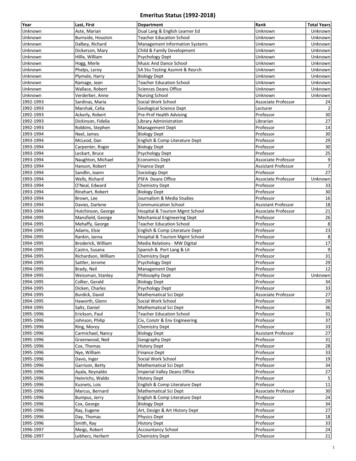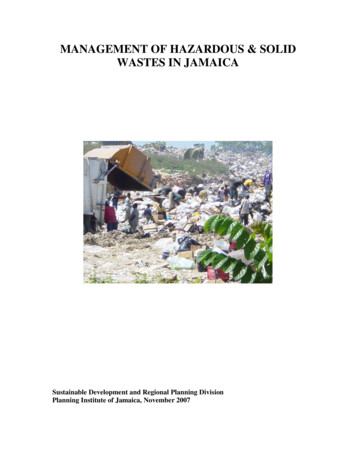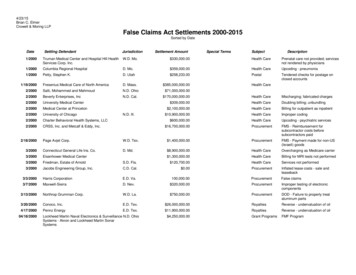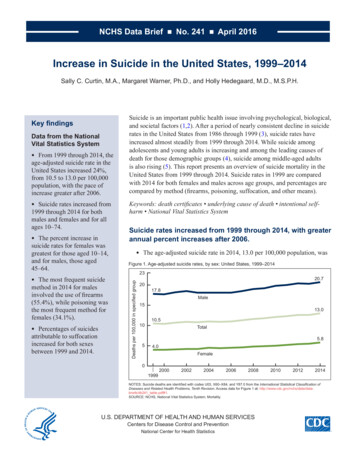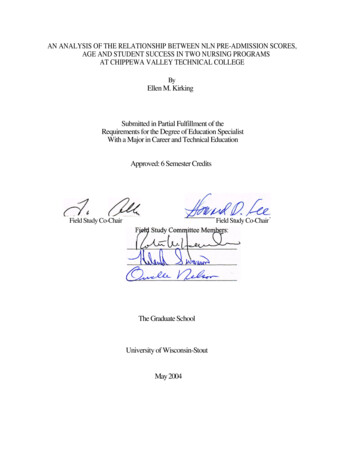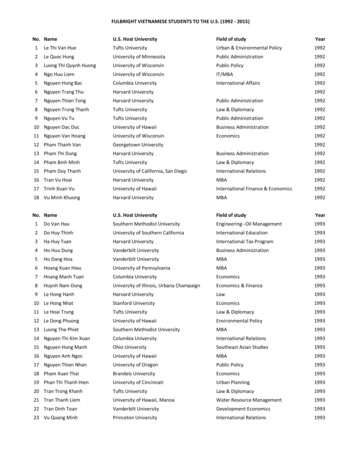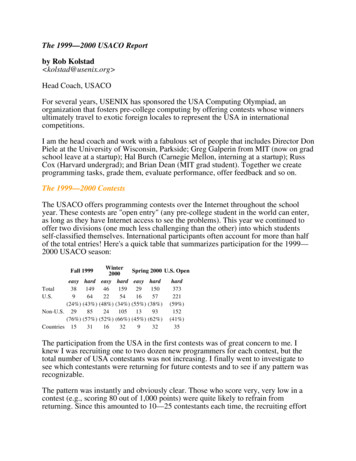
Transcription
The 1999—2000 USACO Reportby Rob Kolstad kolstad@usenix.org Head Coach, USACOFor several years, USENIX has sponsored the USA Computing Olympiad, anorganization that fosters pre-college computing by offering contests whose winnersultimately travel to exotic foreign locales to represent the USA in internationalcompetitions.I am the head coach and work with a fabulous set of people that includes Director DonPiele at the University of Wisconsin, Parkside; Greg Galperin from MIT (now on gradschool leave at a startup); Hal Burch (Carnegie Mellon, interning at a startup); RussCox (Harvard undergrad); and Brian Dean (MIT grad student). Together we createprogramming tasks, grade them, evaluate performance, offer feedback and so on.The 1999—2000 ContestsThe USACO offers programming contests over the Internet throughout the schoolyear. These contests are "open entry" (any pre-college student in the world can enter,as long as they have Internet access to see the problems). This year we continued tooffer two divisions (one much less challenging than the other) into which studentsself-classified themselves. International participants often account for more than halfof the total entries! Here's a quick table that summarizes participation for the 1999—2000 USACO season:Fall 1999easy hard38149964(24%) (43%)Non-U.S. 2985(76%) (57%)Countries 1531TotalU.S.WinterSpring 2000 U.S. Open2000easy hard easy hardhard461592915037322541657221(48%) (34%) (55%) (38%) (59%)241051393152(52%) (66%) (45%) (62%) (41%)163293235The participation from the USA in the first contests was of great concern to me. Iknew I was recruiting one to two dozen new programmers for each contest, but thetotal number of USA contestants was not increasing. I finally went to investigate tosee which contestants were returning for future contests and to see if any pattern wasrecognizable.The pattern was instantly and obviously clear. Those who score very, very low in acontest (e.g., scoring 80 out of 1,000 points) were quite likely to refrain fromreturning. Since this amounted to 10—25 contestants each time, the recruiting effort
(magazine articles, newsgroups) was required to yield a couple dozen new entries justto stay even!Like a good marketer, I polled some members of the departing group and quicklyfound that they felt they need better training resources in order to compete with theworld-class stars in the upper division.In January, Hal Burch and I set out to create the "USACO Training Pages." Usingmaterial from the previous camp, problems from a myriad of sources, and Russ Coxas a problem analyst, we have created roughly 200 hours of training material for ourcompetitors. If you know pre-college programmers who would like to improve theircontest programming ability, please send them to http://ace.delos.com/usacogate .The system includes sequencing, task grading, and a host of instructional materials onvarious algorithms. These pages are currently targeted at the student with a year or soof programming.We're working to extend them "down" to the novice level this year.The Training Pages have been discreetly announced through the USA since January.Over 300 pre-college students have tried at least some of the pages and the grader hasevaluated 8,393 solution attempts submitted in both C/C and PASCAL. So far, itappears that the training pages are a super success and are creating students that, ifthis year's training camp is any indicator, are the equivalent of two training campsahead of the game!Regrettably, I cannot attribute the improved U.S. Open attendance results solely to thetraining pages. We improved our public relations program for announcing the U.S.Open so much that determining the reason for the dramatic increase is not possible.The 1999—2000 WinnersRanking the winners across four separate contests, some of which were morechallenging than others (e.g., the U.S. Open) is a daunting task.Consistency is an important factor; sometimes contestants "get lucky" once.Furthermore, the contests span the school year and the skill levels of the contestantschange through the year.The 1999—2000 season saw a spectacular performance by Reid Barton, a homeschooled junior from Boston. He won two of the contests (one of them outright). JohnDanaher (one of the many talented students at the Thomas Jefferson High School forScience and Technology located in Virginia) placed fifth, first, second, and fifth for aspectacular final year of eligibility. Sophomore Vladimir Novakovski, also a TJstudent, earned a first and two seconds for the best performance in his age group.Veteran Percy Liang, a New Mexico student also in his final year, earned a first,second, and third.
The U.S. Open yielded some surprising results. Senior Jack Lindamood, a contenderthroughout the year, was the only U.S. student to achieve a perfect score and thusearned the U.S. Open championship crown. In his spare time, Jack programs DSPchips for Texas Instru-ments. Only nine points behind, Thuc (sounds like "took") Vucaptured second place. A junior, Thuc has been in the U.S. only eight months and isstill mastering the English language!Below is a list of the students chosen to attend the USACO training.camp, an eightday affair held just south of Milwaukee at the University of Wiscon-sin's Parksidebranch. Reid Barton, Arlington, MAJacob Burnim, Silver Spring, MDKevin Caffrey, Oakton, VATomasz Czajka, Stalowa Wola, PolandAdam D'Angelo, Redding, CTJohn Danaher, Springfield, VARichard Eager, Alexandria, VAPercy Liang, Phoenix, AZJack Lindamood, Dallas, TXYuran Lu, Presque Isle, MEVladimir Novakovski, Springfield, VAGregory Price, Falls Church, VAGary Sivek, Burke, VASteven Sivek, Burke, VAThuc Vu, Westminster, CATom Widland, Albuquerque, NMThe list contains a whopping seven students from TJHSST in Virginia, includingidentical twins Gary and Steven Sivek. We finally have a finalist from California,which is underrepresented in all our contests for no reason I can determine. Danaher,Liang, and Novakovski were our returning veterans. Four campers (Barton, Danaher,Liang, and Lu) earned a head start on this year's international competition at theBalkan Olympiad a couple of months ago. (See the July ;login: for an account of thatcompetition.)Tomasz Czajka, a Polish veteran who won several USACO contests, was invited asour international representative this year. He provided stellar competition to ourcontestants in both formal and informal competitions.Training CampTraining camp has two direct goals: improve the skills of our top programmers andidentify our four best candidates for gold medals at the international events throughoutthe rest of this season.
Indirectly, the camp and its rewards provide goals for all US contestants throughoutthe competitive year.Contestants arrived at camp on Tuesday, June 20, and departed early on June 28. Twofive-hour contest days highlighted the experiences, with dozens of instructionalmodules, problem attacks, and less formal exercises in between. This year weincorporated several parallel sessions with one coach/four students in an effort toincrease personalized instruction and decrease the "Well, Joe knows the answer so Idon't need to think" phenomenon. I think our effort was quite successful, and we'llcontinue this trend.We implemented Dynamic Program-ming Day, during which Russ Cox organizedlectures, drills, lab problems, and even a set of eight different student presentations ondynamic programming. The presentations were stunning and the students nailed theDP problems on the first contest.The "training notebook," begun in earnest last year, grew to almost 150 pages oftutorials, drills, and programs. We're proud of this resource and believe it helpsstudents throughout their competitive careers.This year's innovations included not only written solution analyses for the contestproblems but also in-depth graphical analyses of the test data and its creation.Informal events included the Nine Men's Morris competition in which campers wroteprograms that played against each other in the traditional English (and other) drinkinggame. Polish contestant Tomasz Czajka's program was undefeated. A (Frisbee-style)Disc Golf Competition was won by Jacob Burnim, while the traditional USACO QuizShow was won by Gary Sivek, who edged out his twin brother Steven 2700-2400 inthe final round.The first round of competition at the camp was an easier round with very high scores(mostly due to success on dynamic programming problems). For the second round, wecranked up the difficulty (see below).After Russ Cox graded all the problems and the group of coaches reviewed thosescores and the finishes throughout the year, four students and one alternate werechosen for the international USACO traveling team. They are: Reid BartonJohn DanaherPercy LiangGregory PriceJacob Burnim (Alternate)
L. to R: Gregory Price, Percy Liang, John Danaher, Reid BartonThe next big contest is slated for late August in Cluj, Romania (in the state ofTransylvania); the t-shirts will be fabulous. The international finals (IOI —International Olympiad on Informatics) will be held the last week of September inBeijing, China. The U.S. team carries with it high hopes for multiple gold medals.The FutureIt's just amazing how much time an endeavor such as this can take, especially once apublicly available set of Web pages is available. We plan to continue the set ofindividual contests on the Internet next year with the same style of divisions (ormaybe even pseudo-divisions that let contestants evaluate themselves better inappropriate subgroups).This next year will be a milestone for the competitions, because we are finally leavingbehind the 16-bit DOS-based compilers that have been de rigueur since the IOI'sinception. These dinosaurs allow contestants access to only 640KB of memory andgenerate terribly slow code. I have chaired (I think I was the chair, anyway) acommittee that is in charge of updating the technology. The current plan is to switchto GNU C/C and Free Pascal on the day after the IOI ends in China.The new compilers enable: automatic problem grading without the problems ofrebooting DOS, file systems that might or might not become corrupted after eachprogram execution, lack of multitasking, and lack of memory protection. This changesthe landscape for available contest types and dramatically eases grading (i.e., IOIgrading for 300 competitors should take closer to a fraction of an hour than the current0.5 to 2 days).
We're looking to grow the level of our competitions and the number of competitorsthroughout the next year.In order to foster computer programming as a more recognized sport, I'm looking atholding a set of dual meets (just like track, tennis, swimming, or football) through theschool year. Each meet will pit one school's team against another's — even if theteams are proximal only via the Internet. It's an easy matter to conduct Webregistration, offer a variety of scoring mechanisms (like swimming? tennis?) and teamorganizations (singles, doubles, etc.) to make some exciting competitions (probablymore so for the contestants than the spectators).The parallelism that enables all the competitions to be just the same except for thecompetitors will be our little high-leverage secret.The problem-grading system used by the Web training pages has proven very reliableand amazingly efficient. Email responses are returned to the submitter often withinjust a couple of seconds.OpportunitiesA couple of items really need a large group focus in our effort. First of all, we needpublicity. If you know students who might be interested in competing, please sendthem to http://www.usaco.org and http://ace.delos.com/usacogate . The USACOpage shows some of the accomplishments of our team over the years and alwayscontains up-to-date info on the latest contests and events.Second, we need additional programming tasks. These are a very special niche ofproblem type that require months (half a year? more?) to learn how to create. Theysuffer from the "Goldilocks Syndrome": they must not be too hard; they must not betoo easy; they must be "just right." If you would like to help contribute to our"problem budget" (which could easily exceed 100 problems for the upcoming year),please contact me at kolstad@ace.delos.com .Acknowledgments and ThanksThe USENIX Association's sponsorship of USACO is invaluable. Our time is spentcreating contests, software, and educational opportunities instead of dressing up andbegging for money. We're working hard to improve our program.Director Don Piele implements a huge number of tasks, including: the USACO Webpage, administering the budget, acting as USENIX liaison, serving as camp operationsmanager, planning all physical plant items for camp (including transportation), andmeals. He is like the genie in Aladdin's lamp: wish for something (a three-hole punch,for example) and it appears within hours.
The four coaches (Brian, Greg, Hal, Russ) work with me throughout the year onproblem creation, solution creation, test data creation, grading, and answering studentquestions from the training pages.All of our assistants donate their time (almost ten days at UW-Parkside just fortraining camp and its setup). It's a great group to work with and continues to createnew and exciting ways to improve our camp.Thanks!Two Challenging TasksHere's an easier problem (three stars out of four) created this year by Hal Burch. It iscowified to keep with the spirit of attending camp in Wisconsin:Cow TalkLike the natives of Africa and their drums, the cows moo to each other over longdistance networks of relay-cows. Cow A moos to Cow B; Cow B passes thatmessage to Cow C, and so on. Cows only moo to specified partners, even if someother cow happens to be close by; and when two cows are partners, it is alwaysthe case that either can moo to the other to relay messages.The speed of sound being finite, some relay links take longer than others. In thiscommunication area, we can calculate the relay time seconds by dividing thedistance between the cows by 100. Let's call the set of cows-who-relay alongwith the list of specific, relaying cow-partners a cow-network. The cow-networkis always set up so that it is possible for any cow to talk to any other.Some cow-networks are better than others. A cow-network's merit is measured interms of the "average communication time between cows." This number is thesum of the total communication times between all possible pairs of cows dividedby the number of pairs of cows; thus a lower number is better. When two cowswish to communicate, they always talk using the relay-cows which give thequickest possible moo transmission.Given a set of cows, their (x,y) grid locations, and their communication partners,determine the link between two (hitherto unconnected) partners which, whenadded, creates a cow-network with the smallest possible figure of merit.This year's hardest problem (four stars) was "Kinergarten" (kine, you know, is anarchaic plural for cow). This problem was couched in terms of a teacher taking theyoung calves on a field trip in which they each held on to a set of strings in order toavoid separating. After a good amount of verbiage, the problem devolves to:
Kinergarten [Burch & Galperin, 2000]Given a set of nodes (no more than 150) and weighted arcs between some ofthem, count the total possible number of different minimal spanning trees. Agiven arc weight appears no more than 10 times. 640KB memory limit. Fiveseconds CPU time limit on a 16-bit compiler on a P2/300.The problem, already quite challenging, is complicated by the fact that the totalnumber doesn't fit in just a few bits, thus requiring the implementation of parts of a"bignum" package just to keep track of the final result.ConclusionThe USACO is alive and well. Our camp participants thought the organization musthave at least several dozen affiliates, given the Web pages, contests, and general "lookand feel" of the public interface.This year was our most successful for increasing participation and raising the bar. Theupcoming challenges are dominated by continuing to gain affiliates, maintain ourquality, and prepare for the 2003 IOI, which is to be held in the USA. Our biggestchallenge for 2003 is finding sponsors for the IOI.
Piele at the University of Wisconsin, Parkside; Greg Galperin from MIT (now on grad school leave at a startup); Hal Burch (Carnegie Mellon, interning at a startup); Russ Cox (Harvard undergrad); and Brian Dean (MIT grad student). Together we create programming tasks, grade them, evaluate performance, offer feedback and so on. The 1999—2000 .


